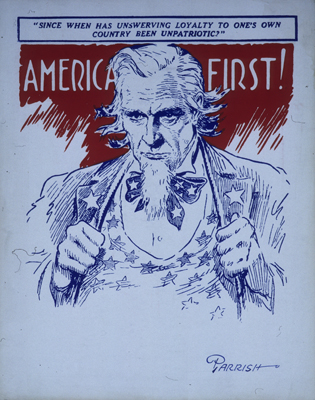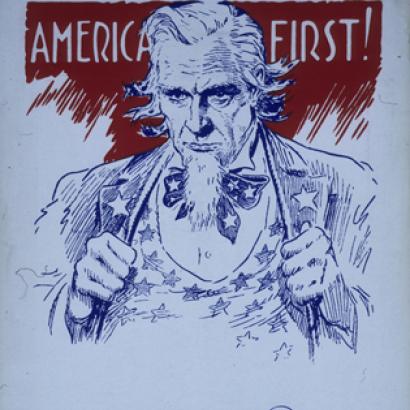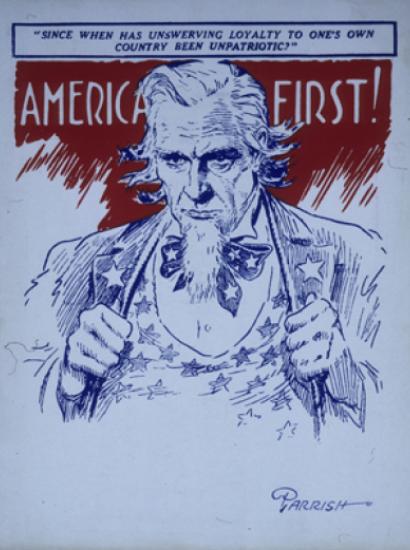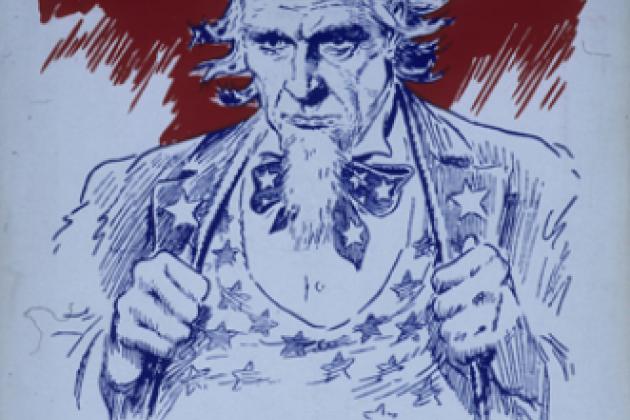- Politics, Institutions, and Public Opinion

Since the Trump team labeled its foreign policy “principled realism” before carrying out much of it, the term is not a description of things accomplished. Instead, it tells us how the Trump team wants to regard the policies it may pursue and, above all, what it wants others to think of them. Being a label applied to an as-yet largely empty container, it is advertising.
This phenomenon, explored by Daniel Boorstin’s The Image: A Guide To Pseudo-Events in America (1962), long since migrated from the world of business to politics. Its essence is to lead audiences to think about a product in ways that compensate for what the product lacks. Thus, advertisers describe the toilet paper as soft because they fear users will experience it as rough, and the laxative as fast-acting yet gentle to appeal to those who want one feature but fear the other.
Accordingly, labeling a foreign policy “principled realism” is a preemptive answer to whoever might call it unprincipled or/and unrealistic. But, absent references to the history of events and ideas, as well as to the realities that its authors find salient, the label says zero about “principles” or “reality.” Neglecting to define these points of reference suggests a policy team less concerned with substance than with image—that is, one adrift on events and public opinion.
To divine what we may expect from the Trump team’s foreign policy, we can rely only on its first months’ words and deeds. In fact, their actions have oscillated not between “realism” and “idealism” or any other extremes, but within the narrow band between the foreign policies of Bush and those of Obama, for the team members’ horizons do not extend beyond those of the administrations in which they served.
Iran is as clear an example as any. Candidate Trump vowed to “tear up” Obama’s “deal” with Iran, which could be accomplished just by submitting it to the Senate for ratification. Instead, the Trump administration certifies Iran’s adherence to it, and continues to observe it. Pure Obama. On the other hand, speaking in Saudi Arabia, Trump promised U.S. support for the (Sunni) Arab world’s increased efforts against Iran. Bush, plus. But then, when the Saudis and Emiratis brought pressure against Iran’s only ally in the Gulf, Qatar, the U.S. government set about not so quietly supporting Qatar, and hence Iran. Something in between Bush and Obama, and a bit of both. Seeking a properly descriptive label for this sort of thing is futile.
After Afghanistan’s Northern Alliance of Tajiks and Uzbeks had well-nigh destroyed the Pashtun Taliban in 2001, the Bush administration committed some 33,000 U.S. troops to support a central government of its own creation. Between 2009 and 2011 Obama tripled that number, then reduced it to fewer than 9,000—changing rhetorical rationales notwithstanding—to prevent the Taliban, defined as any who fight the government, from overthrowing it. Trump had promised to leave Afghans to their own devices. But in August 2017, he told the voters that both he and they had been wrong. Having been schooled by the experts, he would keep U.S. troops in Afghanistan and send some 4,000 more. But this time “to win.” His team explained that this only meant that the Afghan government would not be allowed to fall on Trump’s watch. Apart from the number of troops involved, the explicit narrowing of purpose to staving off the Afghan government’s fall—rather than realism or idealism—is such distinction as exists between Trump’s 2017 policy and Bush/Obama’s of 2002-2016.
The Trump team’s actions with regard to Russia and China have stayed within his predecessors’ even narrower range.
Vladimir Putin seeks to make post-Soviet Russia great. G.W. Bush did his best to soothe him, by adhering unilaterally to the 1972 ABM Treaty’s essentials while withdrawing from it formally. Thus, by sidestepping Republican demands for missile defense, Bush preserved the importance of the arsenal on which Russia’s claim to great power rests. Nevertheless, in 2008, Putin annexed two of Georgia’s provinces. Bush then placed token sanctions on Russia. Obama mitigated them, and sent Secretary of State Hillary Clinton to Moscow with a red “reset” button. Obama also stopped Bush’s anti-Iran missile defense installations in Eastern Europe and promised Putin to restrict U.S. missile defense programs even further. But after Ukraine revolted against Russia in 2014 and Russia seized the Crimea, Obama denounced Russian expansionism more strongly than Bush and imposed even more sanctions. He also agreed to token NATO troop deployments in Eastern Europe. But because sixteen years of Bush/Obama did not strengthen America vis-à-vis Russia, they neither braked Putin nor advanced American interests.
Donald Trump seems to have come into office intending to end the sterile standoff by agreeing on spheres of influence in Europe and the Middle East. But the Democratic party’s allegations that Russia engineered his election victory precluded pursuing this possibility (with the exception of U.S. and Russian forces’ de facto mutual avoidance in Syria). Hence, if only for domestic political self-defense, the Trump team doubled down on Obama’s strategy, which had doubled down on Bush’s: demanding that Russia restore the Crimea to Ukraine, ramping up sanctions, and deploying token forces in Eastern Europe, but without changing the U.S./Russia ratio of military power. Trump promises more money for the U.S. military, and even “many billions” for missile defense. But he has refused to change the longstanding U.S. policy to put no obstacle in the way of Russian (or Chinese) missiles heading for America.
This is reminiscent of Franklin Roosevelt’s continuity with Herbert Hoover’s 1931 Japan policy: demand the restoration of Manchuria, impose sanctions, and keep token garrisons nearby. The discrepancy between ends and means did not work out well.
Continuity and consistency also characterize the Bush, Obama, and Trump administrations’ words and deeds regarding China, Japan, and Korea: Try to keep Japan and South Korea in America’s security orbit and essentially unarmed by offering them protection, mostly against China, but also against North Korea; Watch with wringing hands as China quietly grows its ballistic missile force and capacity to control the ocean from the land; Worry loudly as North Korea advertises its nuclear and missile programs; Ask China to rein in North Korea and smile as it promises to do so; Frown while watching China break its promise with a smile; Build defenses against a token number of North Korean missiles as part of an $80 billion U.S. missile defense program, designed to reassure China that none of that can defend against its missiles; Worry as North Korea’s threat grows and China happily offers its protection to South Korea and Japan; Worry seriously as North Korea’s nuclear and missile programs acquire the capacity to strike mainland America.
In mid-2017 however, it became clear that North Korea’s programs are producing nuclear-tipped missiles of sufficient quality and quantity to overwhelm the $80 billion U.S. investment in missile defense. The Japanese and South Koreans ask how the Americans, if they cannot protect themselves against North Korea, can protect them against China. They talk of going nuclear. China redoubles its offers of protection. In short, the very premise of post-1945 U.S. policy in the Western Pacific no longer holds. Will the Trump administration try to restore it? Otherwise, what is America’s plan for dealing with the Western Pacific under new circumstances?
Thus far, the Trump team has shown continuity and consistency with past policy: Do everything to reassure allies, short of angering China. For example, Trump’s commitment to more money and game-changing technology with regard to missile defense, involving as it does only North Korea and founded on things now non-existent, may not upset China. But it is unlikely to reassure anybody.
In sum, in the Western Pacific as well as elsewhere, the Trump team’s foreign policy oscillates within narrow bands because its members have shown neither the interest nor the capacity to transcend them.















